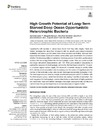Please use this identifier to cite or link to this item:
https://accedacris.ulpgc.es/handle/10553/59925
| DC Field | Value | Language |
|---|---|---|
| dc.contributor.author | Sebastián Caumel, Marta | en_US |
| dc.contributor.author | Estrany, Margarita | en_US |
| dc.contributor.author | Ruiz-Gonzalez, Clara | en_US |
| dc.contributor.author | Forn, Irene | en_US |
| dc.contributor.author | Sala, Maria Montserrat | en_US |
| dc.contributor.author | Gasol, Josep M. | en_US |
| dc.contributor.author | Marrase, Celia | en_US |
| dc.date.accessioned | 2019-12-19T11:41:05Z | - |
| dc.date.available | 2019-12-19T11:41:05Z | - |
| dc.date.issued | 2019 | en_US |
| dc.identifier.issn | 1664-302X | en_US |
| dc.identifier.other | WoS | - |
| dc.identifier.uri | https://accedacris.ulpgc.es/handle/10553/59925 | - |
| dc.description.abstract | Experiments with bacteria in culture have shown that they often display "feast and famine" strategies that allow them to respond with fast growth upon pulses in resource availability, and enter a growth-arrest state when resources are limiting. Although feast responses have been observed in natural communities upon enrichment, it is unknown whether this blooming ability is maintained after long periods of starvation, particularly in systems that are energy limited like the bathypelagic ocean. Here we combined bulk and single-cell activity measurements with 16S rRNA gene amplicon sequencing to explore the response of a bathypelagic community, that had been starved for 1.6 years, to a sudden organic carbon supply. We observed a dramatic change in activity within 30 h, with leucine incorporation rates increasing over two orders of magnitude and the number of translationally active cells (mostly Gammaproteobacteria) increasing 4-fold. The feast response was driven by a single operational taxonomic unit (OTU) affiliated with the Marinobacter genus, which had remained rare during 7 months of starvation. Our work suggests that bathypelagic communities harbor a seed bank of highly persistent and resourceful "feast and famine" strategists that might disproportionally contribute to carbon fluxes through fast responses to occasional pulses of organic matter. | en_US |
| dc.language | eng | en_US |
| dc.relation.ispartof | Frontiers in Microbiology | en_US |
| dc.source | Frontiers In Microbiology [ISSN 1664-302X], v. 10 (760) | en_US |
| dc.subject | 251001 Oceanografía biológica | en_US |
| dc.subject.other | Newly Synthesized Proteins | en_US |
| dc.subject.other | Organic-Matter | en_US |
| dc.subject.other | Marine | en_US |
| dc.subject.other | Carbon | en_US |
| dc.subject.other | Sea | en_US |
| dc.subject.other | Quantification | en_US |
| dc.subject.other | Long-term starvation | en_US |
| dc.subject.other | Particles | en_US |
| dc.subject.other | Survival | en_US |
| dc.subject.other | Archaea | en_US |
| dc.subject.other | Microbial seed bank | en_US |
| dc.subject.other | Prokaryotes | en_US |
| dc.subject.other | Bathypelagic | en_US |
| dc.subject.other | Deep ocean | en_US |
| dc.subject.other | Bacteria | en_US |
| dc.title | High Growth Potential of Long-Term Starved Deep Ocean Opportunistic Heterotrophic Bacteria | en_US |
| dc.type | info:eu-repo/semantics/Article | en_US |
| dc.type | Article | en_US |
| dc.identifier.doi | 10.3389/fmicb.2019.00760 | |
| dc.identifier.scopus | 85068226071 | |
| dc.identifier.isi | 000464269000001 | - |
| dc.contributor.authorscopusid | 14031974200 | |
| dc.contributor.authorscopusid | 57198447098 | |
| dc.contributor.authorscopusid | 51864637500 | |
| dc.contributor.authorscopusid | 14055741200 | |
| dc.contributor.authorscopusid | 7103244252 | |
| dc.contributor.authorscopusid | 7003299234 | |
| dc.contributor.authorscopusid | 6603922904 | |
| dc.relation.volume | 10 | - |
| dc.investigacion | Ciencias | en_US |
| dc.type2 | Artículo | en_US |
| dc.contributor.daisngid | 30892380 | |
| dc.contributor.daisngid | 26446054 | |
| dc.contributor.daisngid | 1834794 | |
| dc.contributor.daisngid | 2393681 | |
| dc.contributor.daisngid | 773010 | |
| dc.contributor.daisngid | 97985 | |
| dc.contributor.daisngid | 444104 | |
| dc.contributor.wosstandard | WOS:Sebastian, M | |
| dc.contributor.wosstandard | WOS:Estrany, M | |
| dc.contributor.wosstandard | WOS:Ruiz-Gonzalez, C | |
| dc.contributor.wosstandard | WOS:Forn, I | |
| dc.contributor.wosstandard | WOS:Sala, MM | |
| dc.contributor.wosstandard | WOS:Gasol, JM | |
| dc.contributor.wosstandard | WOS:Marrase, C | |
| dc.date.coverdate | Abril 2019 | |
| dc.identifier.ulpgc | Sí | es |
| dc.description.sjr | 1,69 | |
| dc.description.jcr | 4,235 | |
| dc.description.sjrq | Q1 | |
| dc.description.jcrq | Q2 | |
| dc.description.scie | SCIE | |
| item.fulltext | Con texto completo | - |
| item.grantfulltext | open | - |
| crisitem.author.fullName | Sebastián Caumel, Marta | - |
| Appears in Collections: | Artículos | |
SCOPUSTM
Citations
32
checked on Jun 8, 2025
WEB OF SCIENCETM
Citations
33
checked on Jun 8, 2025
Page view(s)
155
checked on Feb 22, 2025
Download(s)
169
checked on Feb 22, 2025
Google ScholarTM
Check
Altmetric
Share
Export metadata
Items in accedaCRIS are protected by copyright, with all rights reserved, unless otherwise indicated.
